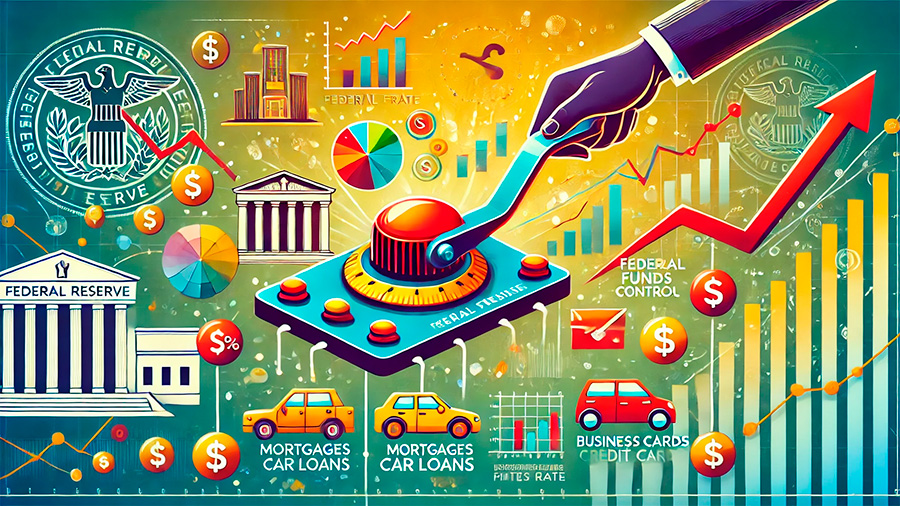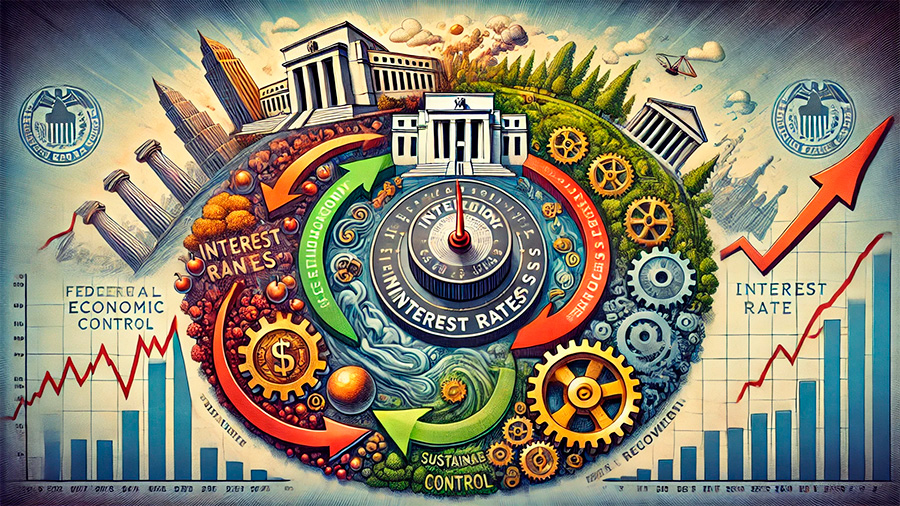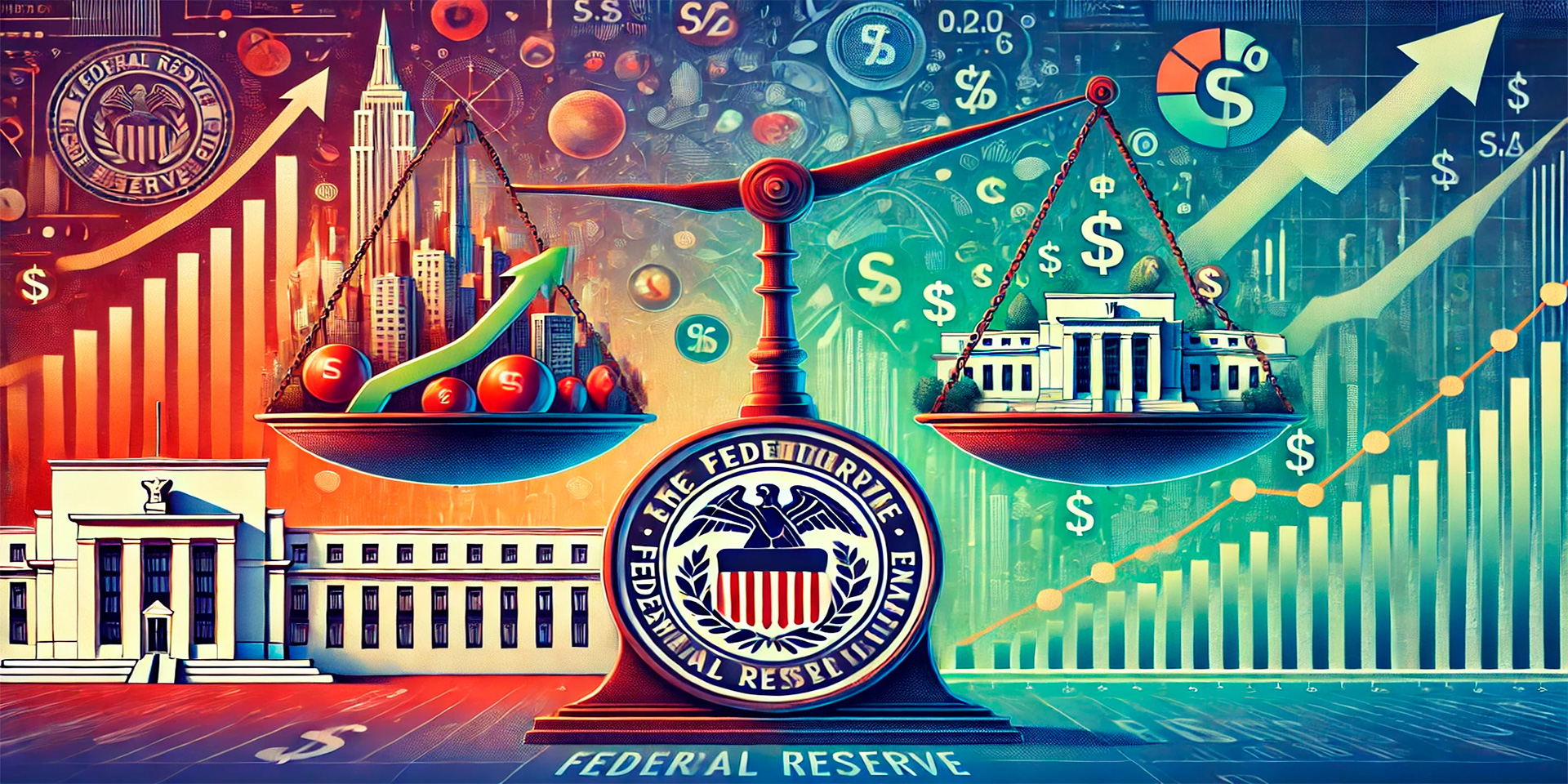Balancing Economic Growth and Inflation: The Federal Reserve’s Approach to Interest Rates
The Federal Reserve (Fed) plays a pivotal role in shaping the U.S. economy by balancing two critical objectives: promoting economic growth and controlling inflation. This balancing act is essential because both objectives can sometimes conflict with one another. Too much focus on growth can lead to high inflation, while tightening policies to curb inflation can slow down economic growth. The primary tool the Fed uses to manage this delicate balance is interest rate adjustments.
In this article, we’ll explore how the Fed uses its powers to regulate the economy, maintain price stability, and support sustainable growth. We’ll break down the mechanics of interest rate changes, their effects on inflation and economic expansion, and how the Fed aims to keep the economy on an even keel.
The Fed’s Dual Mandate: Growth and Inflation
The Federal Reserve operates under a dual mandate set by Congress: to achieve maximum employment and maintain stable prices. In simpler terms, this means fostering conditions that allow the economy to grow while keeping inflation in check. These two goals are interconnected, but achieving one can sometimes create challenges for the other.
1. Promoting Economic Growth
Economic growth is essential for improving living standards, creating jobs, and increasing overall prosperity. The Fed encourages growth by ensuring that credit is readily available and affordable, making it easier for consumers and businesses to borrow money, invest, and spend.
- Low interest rates stimulate growth: When the Fed lowers interest rates, borrowing becomes cheaper for both consumers and businesses. Lower rates encourage spending on big-ticket items like houses, cars, and business investments in new equipment or expansion. This increase in demand leads to higher economic output and job creation.
- Full employment: A key aspect of economic growth is the goal of achieving maximum employment. When the economy grows, businesses hire more workers, reducing unemployment rates. This leads to higher consumer spending, further boosting economic activity.
However, if the Fed pushes too hard on growth by keeping interest rates too low for too long, it can fuel inflationary pressures, leading to rising prices across the board.
2. Controlling Inflation
Inflation occurs when prices of goods and services rise over time, reducing the purchasing power of money. Moderate inflation is normal and even desirable in a growing economy, but runaway inflation can be highly damaging. The Fed’s second mandate is to ensure that inflation remains under control, typically aiming for an inflation rate around 2%.
- High inflation reduces purchasing power: When inflation rises too quickly, consumers find that their money doesn’t go as far. Wages may not keep pace with rising prices, leading to a decline in living standards. High inflation can also create uncertainty in the economy, discouraging long-term investments by businesses and consumers.
- Interest rates and inflation: The primary way the Fed controls inflation is by adjusting interest rates. When inflation starts to rise too quickly, the Fed can raise interest rates, making borrowing more expensive. This reduces spending and investment, cooling down the economy and easing inflationary pressures.
While controlling inflation is important, raising rates too aggressively can slow economic growth and even push the economy into a recession. The Fed’s challenge is finding the right balance between these competing priorities.

How Interest Rate Changes Affect the Economy
The Fed’s main tool for balancing growth with inflation control is its ability to set the federal funds rate, the interest rate at which banks lend to each other overnight. This rate serves as a benchmark for many types of loans, from mortgages and car loans to business loans and credit cards. By raising or lowering the federal funds rate, the Fed can influence economic activity and inflation.
1. Lowering Interest Rates to Promote Growth
When the economy is sluggish or in a recession, the Fed lowers interest rates to stimulate growth. Lower borrowing costs make it more attractive for consumers and businesses to spend and invest, which boosts economic activity.
- Consumer spending increases: Lower interest rates reduce the cost of financing big purchases like homes, cars, and appliances. As consumers take advantage of cheaper loans, demand for goods and services rises, driving economic expansion.
- Business investment grows: For businesses, lower interest rates reduce the cost of borrowing for capital investments, such as purchasing new equipment, expanding operations, or hiring more workers. This increases production and leads to job creation.
- Stock market boost: Lower interest rates also tend to push up stock prices, as lower returns on bonds and savings make stocks more attractive to investors. This creates a wealth effect, where individuals feel more financially secure and are more likely to spend.
However, if the Fed keeps rates too low for too long, the increase in demand can outpace supply, leading to higher prices and inflationary pressures.
2. Raising Interest Rates to Control Inflation
When inflation rises too quickly, the Fed raises interest rates to cool down the economy. Higher interest rates make borrowing more expensive, which slows consumer spending and business investment, reducing demand and ultimately curbing inflation.
- Reduced consumer borrowing: Higher interest rates lead to higher mortgage, auto loan, and credit card rates, making it more expensive for consumers to borrow. As a result, people may cut back on large purchases, reducing demand and slowing price increases.
- Slower business investment: With higher borrowing costs, businesses may delay expansion plans, reduce hiring, or hold off on making large capital expenditures. This helps cool down economic activity and lowers inflationary pressure.
- Lower stock prices: As interest rates rise, bonds and savings accounts offer better returns, making them more attractive to investors compared to stocks. This can lead to a decline in stock prices, reducing the wealth effect and further dampening consumer spending.
While raising interest rates is an effective way to control inflation, doing so too quickly or by too much can push the economy into a recession, causing widespread job losses and reduced economic output.

How the Fed Responds to Different Economic Conditions
The Fed uses interest rate changes to respond to different phases of the economic cycle, ensuring that inflation remains stable while promoting sustainable growth. The timing and size of rate changes depend on the economic conditions the Fed is trying to address.
1. During Economic Expansion
In a growing economy, the Fed’s primary concern is managing inflation. As the economy expands, consumer and business spending increases, which can lead to higher prices if supply cannot keep up with demand. During these periods, the Fed may gradually raise interest rates to prevent the economy from overheating.
- Gradual rate increases: The Fed typically raises rates slowly to avoid disrupting economic growth while keeping inflation in check. This allows the economy to continue growing at a sustainable pace while preventing excessive price increases.
- Monitoring inflation expectations: The Fed closely monitors inflation expectations—how consumers and businesses expect prices to change in the future. If expectations become unanchored and people start expecting higher inflation, the Fed may take more aggressive action to raise rates and restore confidence in price stability.
During economic expansions, the Fed’s goal is to maintain a balance between fostering continued growth and keeping inflation within target levels.
2. During Economic Recessions
In a recession or period of economic contraction, the Fed’s primary goal shifts to stimulating growth and preventing deflation (a general decline in prices). During these times, the Fed typically lowers interest rates to encourage spending and investment.
- Aggressive rate cuts: In response to a sharp economic downturn, the Fed may implement significant interest rate cuts to make borrowing cheaper and more attractive. This helps boost demand, prevent deflation, and stabilize the economy.
- Quantitative easing: When interest rates are already near zero, the Fed may use unconventional tools like quantitative easing (QE). QE involves buying large amounts of government bonds and other financial assets to inject liquidity into the economy and further lower long-term interest rates.
The Fed’s actions during a recession are designed to kickstart economic growth by making it easier for consumers and businesses to access credit and spend money.
Challenges of Balancing Growth and Inflation
Finding the right balance between promoting growth and controlling inflation is one of the biggest challenges faced by the Federal Reserve. The Fed’s decisions are based on a wide range of economic data, but unexpected events and external shocks can complicate its efforts to achieve its dual mandate.
1. Timing and Uncertainty
The impact of interest rate changes isn’t immediate, and it can take months or even years for the full effects to be felt throughout the economy. This lag makes it difficult for the Fed to time its actions perfectly, and there is always the risk of overshooting or underreacting to economic conditions.
- Late action: If the Fed raises rates too late in an inflationary cycle, prices may spiral out of control, forcing more aggressive rate hikes that can disrupt the economy.
- Premature tightening: Conversely, if the Fed raises rates too early or by too much, it can slow down economic growth unnecessarily, causing a recession.
The lag between policy changes and economic outcomes creates a challenge for the Fed in accurately forecasting future economic conditions.
2. External Shocks
The Fed’s ability to balance growth and inflation can also be disrupted by external shocks, such as geopolitical events, supply chain disruptions, or unexpected changes in global energy prices. These shocks can affect inflation and economic growth in ways that are difficult to predict or control.
- Supply-side inflation: External events like oil price spikes or trade disruptions can lead to higher costs for businesses, pushing up inflation even as demand remains weak. This can create a dilemma for the Fed, as raising rates to control inflation could further weaken economic growth.
- Global factors: The global economy is interconnected, and changes in foreign markets, such as currency fluctuations or central bank policies in other countries, can impact U.S. inflation and growth, complicating the Fed’s decision-making process.
External shocks can throw the Fed’s carefully calibrated policy plans off course, forcing it to adapt quickly to new economic realities.
Final Thoughts: The Fed’s Role in Balancing Growth and Inflation
The Federal Reserve’s dual mandate to promote economic growth and control inflation requires a careful balancing act. By adjusting interest rates and managing the money supply, the Fed works to maintain price stability while fostering conditions for sustainable growth. However, the complexities of the economy, timing challenges, and external shocks make this task far from easy.
For consumers and investors, understanding the Fed’s role in managing the economy is crucial for making informed financial decisions. Whether you’re borrowing money, investing in the stock market, or planning for the future, staying attuned to changes in Fed policy can help you navigate the economic landscape more effectively.

